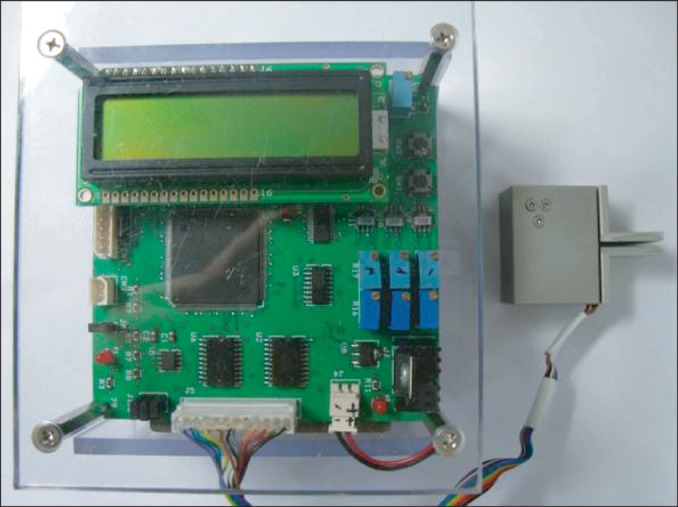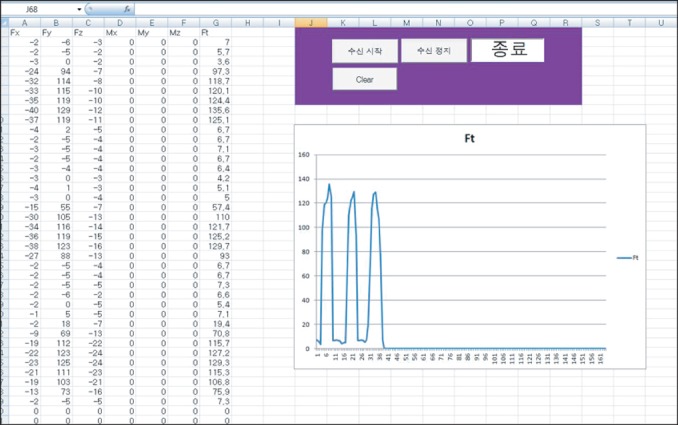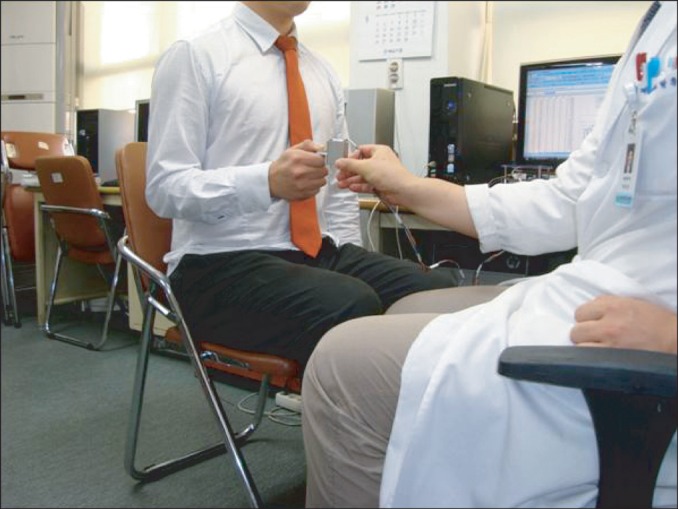Ann Rehabil Med.
2012 Jun;36(3):394-399. 10.5535/arm.2012.36.3.394.
Reliability of the Pinch Strength with Digitalized Pinch Dynamometer
- Affiliations
-
- 1Department of Rehabilitation Medicine, Gyeongsang National University Hospital, Jinju 660-702, Korea. yoonch@gnu.ac.kr
- 2Control and Instrumentation Engineering, ERI, Gyeongsang National University, Jinju 660-702, Korea.
- KMID: 2266746
- DOI: http://doi.org/10.5535/arm.2012.36.3.394
Abstract
OBJECTIVE
To examine the intra-rater, inter-rater, and inter-instrumental reliability of the digitalized pinch muscle strength dynamometer. METHOD: Thirty normal subjects were examined for pinch strength, using both the Preston pinch gauge and the digitalized pinch dynamometer. The participants performed all pinch strength tests in the seated position as recommended by the American Society of Hand Therapists (ASHT). Three successive measurements were taken for each hand. The mean of the three trials was used for data analysis. The pinch strength tests performed used a repeated measure design and measurements were taken by each rater.
RESULTS
The relationship between the Preston pinch gauge and the digitalized pinch dynamometer in pinch strength was reliable (the ICC were 0.821 and 0.785 in rater 1 and rater 2 respectively). The relationship between the first session and second session in pinch strength using the digitalized pinch dynamometer was reliable (the ICC were 0.872 and 0.886 in rater A and rater B respectively). The relationship between rater A and rater B in pinch strength using the digitalized pinch dynamometer was reliable (the ICC was 0.754).
CONCLUSION
The pinch strength measurement using the digitalized pinch dynamometer is reliable within the rater and between raters. Thus, the Preston pinch gauge and the digitalized dynamometer measure grip strength equivalently, and can be used interchangeably.
MeSH Terms
Figure
Cited by 1 articles
-
Relationship Between Grip and Pinch Strength and Activities of Daily Living in Stroke Patients
Jung Hyun Bae, Si Hyun Kang, Kyung Mook Seo, Don-Kyu Kim, Hyun Iee Shin, Hye Eun Shin
Ann Rehabil Med. 2015;39(5):752-762. doi: 10.5535/arm.2015.39.5.752.
Reference
-
1. Balogun JA, Akomolafe CT, Amusa LO. Grip strength: effects of testing posture and elbow position. Arch Phys Med Rehabil. 1991; 72:280–283. PMID: 2009042.2. Myers DB, Grennan DM, Palmer DG. Hand grip function in patients with rheumatoid arthritis. Arch Phys Med Rehabil. 1980; 61:369–373. PMID: 7406675.3. Han SH, Nam KS, Ahn TK, Dan JM. Analysis of grip and pinch strength in Korean people. J Korean Orthop Assoc. 2009; 44:219–225.
Article4. Mathiowetz V, Kashman N, Volland G, Weber K, Dowe M, Rogers S. Grip and pinch strength: normative data for adults. Arch Phys Med Rehabil. 1985; 66:69–74. PMID: 3970660.5. Richards LG. Posture effects on grip strength. Arch Phys Med Rehabil. 1997; 78:1154–1156. PMID: 9339168.
Article6. Schmidt RT, Toews JV. Grip strength as measured by the Jamar dynamometer. Arch Phys Med Rehabil. 1970; 51:321–327. PMID: 5423802.7. Bechtol CO. Grip test: the use of a dynamometer with adjustable handle spacings. J Bone Joint Surg Am. 1954; 36:820–824. PMID: 13174611.8. Mathiowetz V, Weber K, Volland G, Kashman N. Reliability and validity of grip and pinch strength evaluations. J Hand Surg Am. 1984; 9:222–226. PMID: 6715829.
Article9. Mathiowetz V, Wiemer DM, Federman SM. Grip and pinch strength: norms for 6- to 19-year-olds. Am J Occup Ther. 1986; 40:705–711. PMID: 3777107.
Article10. Talsania JS, Kozin SH. Normal digital contribution to grip strength assessed by a computerized digital dynamometer. J Hand Surg Br. 1998; 23:162–166. PMID: 9607650.
Article11. Shechtman O, Gestewitz L, Kimble C. Reliability and validity of the DynEx dynamometer. J Hand Ther. 2005; 18:339–347. PMID: 16059855.
Article12. Niebuhr BR, Marion R, Fike ML. Reliability of grip strength assessment with the computerized Jamar dynamometer. Occup Ther J Res. 1994; 14:3–18.
Article13. Kim HM, Yoon JW, Shin HS, Kim GS. Development of force measuring system using three-axis force sensor for measuring two-finger force. J Inst Contr Robot Syst. 2010; 16:876–882.
Article14. Fess EE. The need for reliability and validity in hand assessment instruments. J Hand Surg Am. 1986; 11:621–623. PMID: 3760486.
Article15. Mathiowetz V. Comparison of Rolyan and Jamar dynamometers for measuring grip strength. Occup Ther Int. 2002; 9:201–209. PMID: 12374997.
Article16. Hinson M, Woodard J, Gench B. Reliability of the Jamar digital dynamometer model 2A. Occup Ther J Res. 1990; 10:108–110.
Article
- Full Text Links
- Actions
-
Cited
- CITED
-
- Close
- Share
- Similar articles
-
- The Clinical Study of Grip and Pinch Strength in Normal Korean Adult
- Pressure Threshold, Grip and Pinch Strength in Female Telephone Operators
- Study of Upper Extremity Strength Using Jamar Dynamometer, Pinch Gauge, and Multiple Work Simulator in Normal Subjects
- Analysis of Grip and Pinch Strength in Korean People
- Normative Measurements of Grip and Pinch Strengths of 21st Century Korean Population






